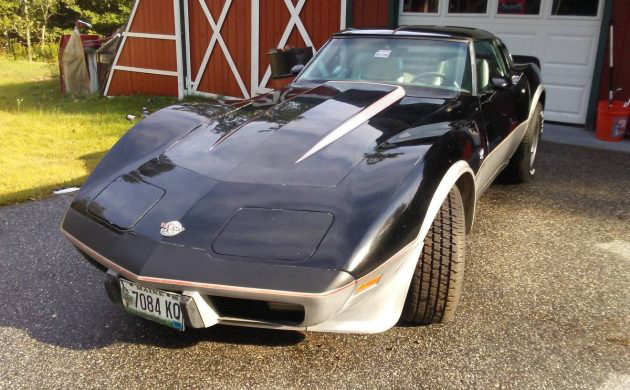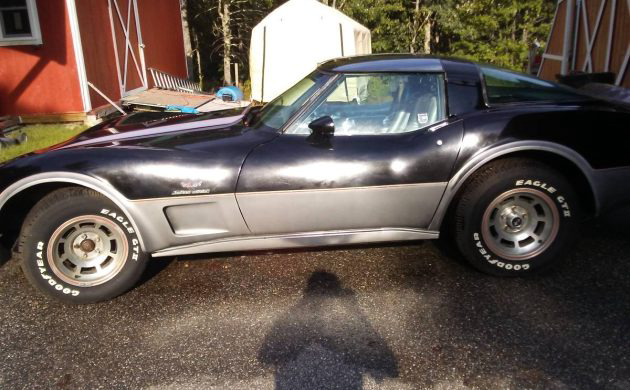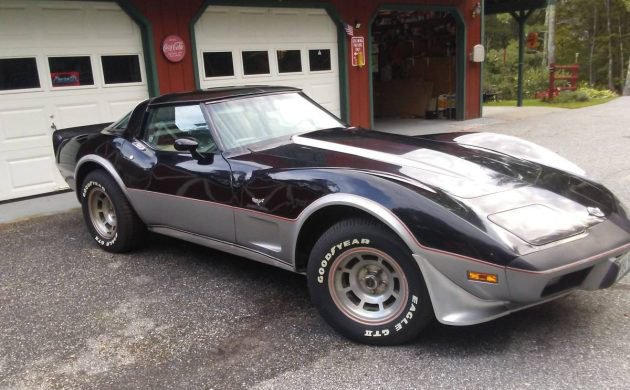Limited Edition Barn Find: 1978 Chevrolet Corvette

By 1978, the Corvette was pretty long in the tooth. With a chassis that was little changed from the 1963 model and a body design that debuted in 1968, the Corvette was steadily updated but slowly became a joke to sports car enthusiasts. Some were waiting for the mid-engine Corvette that was in development but would never arrive in this era. Enter the efforts of the styling and marketing departments at GM to save the day. This 1978 Chevrolet Corvette Commemorative Edition for sale on Craigslist in Gray, Maine is an excellent example of how some decals, a new paint scheme, and a styling update can breathe new life into an automobile. This example is described as a barn find and exhibits some wear. Is the $14,500 asking price out of line for what is arguably one of the most handsome examples of the third-generation Corvette’s long production run?

The history of the third-generation Corvette is a microcosm of the car’s relationship with General Motors’ leadership. There are claims that the car never made a dime for GM until the incredibly popular C4 series and was viewed as a “loss leader” to draw people into the showrooms. While sports car enthusiasts cried out for a more competitive sports car when compared to the European competition, the company spent as little as possible on the car and threatened its very existence numerous times.

They even went so far as to reassign Zora Arkus Duntov, who as its lead engineer was considered the father of the Corvette. Duntov constantly championed for the Corvette to be the best America could offer, and his incessant badgering and maneuvering hurt his career and won him few friends at the top levels. When the C3 came out, the company had already reassigned him to put an end to dealing with the tenacious Duntov. The 1968 Corvettes that Car and Driver magazine tested were so abysmally constructed that the magazine refused to test the car and said so in print. The corporation was highly embarrassed to the point that Duntov was begrudgingly returned to his former position to lead the Corvette into the seventies.

Sadly, Duntov had little to work with to improve the car until his retirement in the mid-1970s. He was given little budget and emissions and crash regulation forced development to go in directions that were not performance-related. Undaunted, he focused his energy on designing a mid-engine Corvette based on the upcoming Wankel engine that GM had in development. Duntov had no love of the Wankel engine, but he knew it was his last shot at designing the car he wanted. When that project floundered, any dreams of a mid-engine Corvette died with it. Duntov retired in 1975 and was succeeded by Dave McClellan.

While McClellan was spending a lion’s share of his time spearheading the development of what would debut as the C4 as a 1984 model-year automobile, the C3 went through some design changes that made it look more aerodynamic and, to some degree, larger. Emphasis was put on luxury over performance, and many special editions were sold until production stopped in 1982. The looks were there, but there is not a lot you can do with a 1963-era chassis and a body introduced in 1968. The “what ifs” of the Corvette in this era are interesting to contemplate. If a mid-engine car was produced back then, how far along would the Corvette be today? It is hard to see this as anything other than a lost decade punctuated by special editions.
One of the most popular of the special edition Corvettes of this era is the 1978 Limited Edition Corvette. Chevrolet attached 25th-anniversary badges to every Corvette that year to celebrate the production of the car since its start in 1953. A Silver Anniversary special edition car in, you guessed it, silver paint was produced. Furthermore, a top-of-the-line Limited Edition was produced to both pace the Indy 500 that year and to make a lot of money selling fully optioned vehicles. One was allocated for each of the 6,502 Chevrolet dealers in existence at the time. Despite having a sticker that was far and above the base price, the demand for these cars was so fierce that lawsuits were filed by disgruntled customers denied the privilege of purchasing one. Of course, the additional markup on these cars (now eloquently called a “market adjustment“)was obscene at some dealerships.
The irony of this 1978 Corvette Limited Edition you see here is that it appears to have been enthusiastically used. A large percentage of the 6,502 built have enjoyed white glove treatment since they rolled off the lot in 1978. Many buyers thought that they would appreciate and treat them as an investment rather than a car. That theory held for a while, but time eventually passed these cars by leaving many in impeccable shape with low price tags.
Whoever has owned this car since new took the smart route and enjoyed the car for what it is. With 70,000 miles listed in the ad and some fading and signs of use, this car hasn’t spent a lot of time being polished and pampered. While the seller tells us that the car has been stored since 2016, we know precious little else. The ad states that it has the original paint and wheels and has a new in-the-box carpet included with the sale. There are no pictures of the interior or the engine.
As with every Corvette, paying an expert to inspect the car would be prudent. Limited Edition cars had special serial numbers that prevented them from being faked. The problem is that the Corvettes of this era have issues with theft, shoddy parts, abuse, and many other ways for a buyer to make a mistake. This one looks rather straightforward, but the lack of pictures and the condition could be an issue.
Is this Corvette worth $14,500? Maybe if you are looking for a driver-level car with this package to enjoy and fix up as time and money allow. Could you buy a better example and have less money in the car after a paint job and maybe an interior? Yes. It all depends on what you want to do and how much you enjoy the journey to get to that perfect Corvette for you.
What would you do with this Corvette if it were yours? Would you fix it up, or drive the wheels off of it as it sits? Do you feel that the 1978 Corvette should have been a mid-engine car? Please share your thoughts in the comments.
Auctions Ending Soon
 2002 Subaru Impreza WRXBid Now2 days$333
2002 Subaru Impreza WRXBid Now2 days$333
 1975 Chevrolet Corvette ConvertibleBid Now2 days$4,000
1975 Chevrolet Corvette ConvertibleBid Now2 days$4,000
 1964 Ford F-100 Camper CustomBid Now2 days$2,000
1964 Ford F-100 Camper CustomBid Now2 days$2,000
 2006 Jeep Wrangler SportBid Now4 days$10,500
2006 Jeep Wrangler SportBid Now4 days$10,500
 1974 Datsun 260ZBid Now6 days$750
1974 Datsun 260ZBid Now6 days$750

Comments
As you say, in ’78 the Vette wasn’t what it had been, or what it could have been. But it was still the domestic upper crust sexy beast of the day. To reverse the old adage: a diminishing tide lowers all boats. The Camaro/Firebird was, similarly, rolling an outdated chassis w/ diminished power. And Mustang was II. Too bad there are no interior shots, as those silver leather seats are still my favorite. To me, they look like those promised earlier in the Sting Ray / Mako Shark show cars. (Isn’t this the bean counter version of the Mako Shark paint: a hard line color change instead of the dark to light descending fade?) Glad to see someone enjoyed it.
Completely disagree. The 1978-1982 Corvettes were the best looking Vettes ever. (Except when given these ugly 2 tone paint jobs.) Their immediate successors, on the other hand, were the ugliest Vettes ever.
I am not a fan of this tacked on ’78 rear spoiler – the later one integrated into the bumper cover looks a lot better.
The worse thing car manufacturers started to do in the later ’70s was to paint over the steel shiny front & rear window moldings with flat black paint, which would eventually start to peel off, as seen here, as well as on aged 2nd gen f-bodies, mustang IIs, etc.
Regarding ugliness, I think you mean the CURRENT Ferrari wannabe successor, with its ugly face front & rear ends, & JCW looking black addons. Too bad they didn’t use the mid engined 4 rotor corvette’s body(or its
XP-882 successor’s) instead – they LOOK like corvettes – with their longer hoods, despite being mid- engined.
I’m with Jim … these were good looking cars indeed. My brother’s 78 underwent a restoration that included a wake up call for the original 350. It is now fast and slick.
It’s really not much of a limited edition, in spite of what the cheap decals say. 6502 pace car replicas out of 46,776 Corvettes in total means that more than one in 10 was a pace car replica. In fact, the only Corvette that was more common was the silver anniversary car, at 15,283 units. Every standard color Corvette was less common.
You got it right. I don’t know if these invented the dreaded markup but I still remember that clearly. People were paying hide and hair for these things and it was all over the news I always thought that was dumb because it was really just a trim option for what was by then a slow boulevard cruiser for the disco set, but that didn’t stop ’em. The W72 Trans Am of that same year was a much better car and a lot cheaper.
Just a tad high on asking. I’d say a solid 12k. These body styles were sexy. Unmistakenly “Vette”.
These were my favorite years look wise, the Disco Vettes were something to pull up to a club in Long Island with, however like the Trans Am and Camaro, they were all show and not too much go, but everything of that era suffered from emissions and so on, so in comparison to what else was out of Detroit, this and the Trans Am were fast, not next to a 70/71, but next to a Grand Prix or Monte Carlo absolutely
The only vehicle in 77-8 to beat any stock car was the Lil Red Express stepside pickup!!
Because that 2 dr passenger truck had no cat conv – the early pellet cats in cars were very restrictive accounting for a loss of up to 40 hp.
Quite a history less Jeff which most of us know already or can get anywhere!! How about some information on the engine details and drivetrain!! 🤷
Could be a nice cruiser. Not much in the way of horsepower though.
Wouldn’t do much over 8k as is.
Why are there no interior or engine compartment pictures? Makes you wonder.